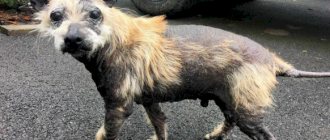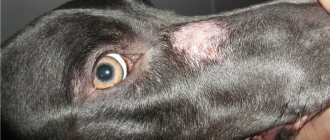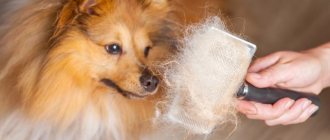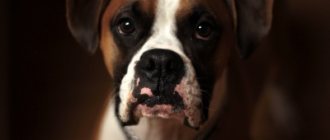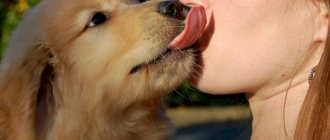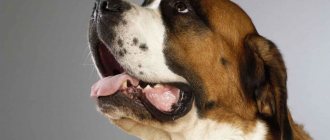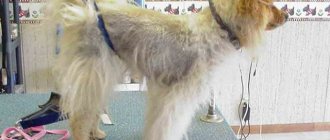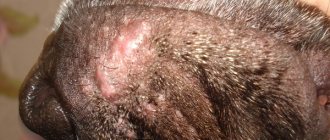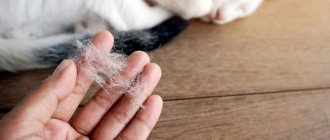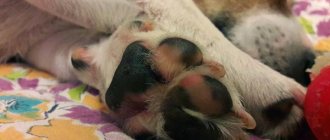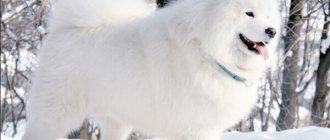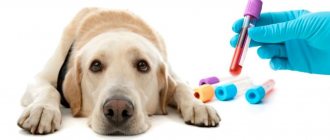Every pet owner needs to know why their dog is losing hair and going bald in places. Owners of animals of different breeds and ages may encounter a similar problem. To eliminate it, they need to immediately contact a veterinarian, provide the pet with full medication treatment and good care.
It must be taken into account that baldness in pets often indicates significant health problems. It may indicate the presence of parasites, changes in hormonal levels, and dermatological diseases. It is important for the owner of the animal to establish the exact cause of this condition of the animal, otherwise he will not be able to cope with hair loss even if he carefully follows the veterinarian’s recommendations.
What is alopecia?
This is hair loss in animals. It may be associated with the natural change of hair coat - molting, but often takes on pathological forms in which the animal experiences baldness of certain parts of the body, the appearance of ulcers and inflammations, as well as tissue pigmentation. Such individuals often have a “fur coat” that comes out in tatters. Such a symptom almost always indicates serious malfunctions in the body’s functioning - hormonal changes, disruption of the functioning of internal organs, or infection of the pet with parasites.
When such a problem arises, the dog owner needs to remain calm. If he notices moderate hair loss in the spring or fall, there is no need to worry. However, if this process begins in winter and is accompanied by a general deterioration in the dog’s condition, the appearance of islands of bare skin on the paws, face, and stomach, you should consult a veterinarian. In most cases, a specialist is able to cope with such a scourge quickly without consequences for the animal’s health.
[custom_ads_shortcode1]
Why might a dog lose hair?
This phenomenon may occur for the following reasons:
- Due to hormonal imbalances. These include hypothyroidism (with this disease there is dysfunction of the thyroid gland, the skin turns black), hyperestrogenism, Cushing's syndrome, hypoestragonism. Also, a similar phenomenon can be observed in bitches during pregnancy and after childbirth. It does not apply to a number of pathologies.
- Because of stress. They may be associated with a change of place of residence, the death of the previous owner of the animal, or the appearance of other animals in the house. In this case, the pet often loses its hair in clumps to bald spots, there is increased excitability, urinary incontinence, and frequent howling. In this situation, the animal must be given sedatives to relieve symptoms.
- Exposure to allergens on the body. These can be ordinary dust, synthetic materials, and some products included in the animal’s diet. Severe itching, dandruff and hair loss can be caused by the use of low-quality hygiene products: bad shampoos, pet care balms, plastic combs, synthetic leashes, collars, clothing.
- Due to severe infection of the body with parasites: ticks, helminths, fleas. In such cases, the owner will observe not only hair loss, but also severe wounds on the pet’s back, as well as on the pet’s neck, around the tail, and lower abdomen. The animal will constantly scratch these areas due to severe itching. The problem can only be eliminated through antiparasitic treatment of the animal.
- With vitamin deficiency. Accompanied by the appearance of bald spots on the ears, as well as on the face and back of the dog. The condition of the animal with such a disease worsens: there is a decrease in appetite, an exacerbation of chronic diseases (if they have occurred). This problem occurs more often in the off-season, which is why it is often confused with regular molting.
- Due to bacterial infections. In such cases, the dog’s hair falls out profusely and it itches. At the same time, the pet becomes bald in places, the thickness of the hair on healthy areas of the skin does not change.
- For fungal infections of tissues. The most common ringworm in dogs is trichophytosis. Puppies under the age of one year are highly susceptible to such diseases. The diseases are accompanied by the formation of ulcers on the skin, thinning hair, and the appearance of dandruff. Such pathologies are very contagious and are easily transmitted from one animal to another through direct contact, bedding, and toys.
- With acanthosis nigricans. This is a lesion of the sebaceous glands, in which pigmentation of the skin is observed in the groin area, as well as under the armpits. Accompanied by severe itching and the appearance of hard scales on the tissues.
- Due to idiopathic alopecia. This is a specific disease to which representatives of the Greyhound breed are prone. Accompanied by hair loss on the abdomen and thighs. The skin with this pathology remains healthy and does not require specific treatment.
- For adenitis of the sebaceous glands. The disease primarily affects puppies. With this pathology, the owner notices that the animal’s hair is falling out, and in this place there is red skin covered with peels or a greasy coating. The disease requires the use of corticosteroid therapy.
- Due to injuries. These include severe bites, burns, and cuts.
Also, hair loss may not be associated with pathological processes in the body. Twice a year, the hair on the dog’s body is renewed naturally and there are periods of shedding. If your pet's general health does not deteriorate during this time, there is no need to worry about this. Wait for this phase to end naturally and continue caring for your pet.
[custom_ads_shortcode2]
Physiological shedding in dogs: when to start panicking?
Dogs with different coat types shed differently.
- Those with a thick double coat shed very heavily: German Shepherd, St. Bernard, Husky, Bernese Mountain Dog, and others.
- An average degree of shedding is typical for short-haired dogs: Chihuahua, bulldog, dachshund, and others.
- Minor shedding or its complete absence - for hairless dogs or those whose hair grows constantly, requiring regular haircuts: Yorkshire Terrier, Maltese, Mexican Hairless, American Hairless Terrier, others.
Seasonal (physiological molting) occurs due to normal mosaic hair replacement. Mainly regulated by photoperiod (length of daylight), and to a lesser extent by ambient temperature. This is why in dogs kept in apartments, seasonality is weakly expressed, shedding is extended and can be almost year-round. For street dogs it occurs twice a year: in autumn and spring. Before cold weather, a thick undercoat grows, and with the onset of warmth, the dog quickly gets rid of it, shedding in clumps.
Puppy shedding begins at about 3 months and ends by 15 months. During this period, the young soft fur is replaced by an adult, coarser one. Puppy shedding is more noticeable in long-haired dogs.
In whelping and lactating dogs, active shedding occurs 1.5-2 months after birth. Not so much because of a lack of nutrients and vitamins, but because of hormonal changes in the body. It is practically impossible to influence this process. Almost all breeds, both long-haired and short-haired, are susceptible to this.
With normal physiological molting, the pet’s condition is assessed as good, no changes in behavior or appearance are observed: greasy hair, dandruff, damage or redness of the skin, bald areas, diffuse alopecia, the dog does not itch.
Seasonal shedding is heavier in the spring, when the winter undercoat sheds.
How to determine the cause of baldness?
If your pet's hair loss is associated with regular shedding, there is no need to worry about it. It is enough to continue to care for his coat, and this process will end naturally. If your animal has severe alopecia, you should consult a veterinarian. He will conduct the following studies to determine the cause of this condition:
- A general examination of the pet, a survey of the dog’s owner, allowing you to determine in what conditions the dog lives, how long ago his hair loss began, and what processes it is associated with. The doctor will definitely clarify whether there have been contacts with wild animals, changes in hormonal levels, and whether the dog has chronic diseases.
- Blood and urine tests.
- Fur scrapings.
- If damage to internal organs is suspected, the animal may be prescribed an ultrasound or x-ray.
Based on the results of such an examination, the doctor will be able to determine the reason why the dog has a lot of hair and will select the appropriate therapy for it. This will allow you to quickly cope with the presented disease.
[custom_ads_shortcode3]
How is the diagnosis carried out?
Diagnosis is carried out in a veterinary clinic. The doctor uses conventional dermatological examination methods. First, the wool is illuminated with a Wood's lamp. It shows lesions of an infectious and parasitic nature. If there is no suspicion, then a skin scraping is taken, as well as trichoscopy (examination under a microscope) of hair from healthy areas. Cytological and histological examinations of the skin are also carried out. To complement the overall picture of the condition, blood tests (routine, hormonal) and ultrasound are performed.
Methods for treating hair loss in dogs
The strategy for combating alopecia is selected depending on the factor that provoked this phenomenon:
- If infected with ticks or worms, antiparasitic treatment will be prescribed. In the most severe cases, treatment for alopecia in dogs will involve antibiotics.
- If there is a lack of vitamins and macroelements in the body, the animal will be prescribed specialized complexes and feeds that have a high content of nutrients.
- If baldness occurs due to an allergy, the animal will be prescribed antihistamines, the owner will be advised to change the diet, as well as replace the dog’s accessories and hair care products (often these are the ones that provoke hair loss).
- In case of hormonal imbalances or severe general diseases, the dog will be prescribed long-term combined treatment aimed at eliminating the cause of alopecia. It may take several months.
To eliminate itching, skin inflammation, and dandruff, the dog will be prescribed special local medications that will need to be applied daily to the affected areas of the skin. Products containing melatonin help well in such cases. They are used until symptoms disappear completely.
If you follow all the veterinarian's recommendations, you can cope with alopecia in a few weeks. In the future, you will need to follow preventive recommendations so that the problem does not arise again.
[custom_ads_shortcode1]
Treatment
In addition to medications, your veterinarian may prescribe the following vitamins:
- vitamin D (fish oil);
- zinc chelate;
- amino acids;
- B vitamins.
All these drugs are included in a special vitamin complex.
In any case, when faced with the problem of pet baldness, do not panic. After all, timely help, as well as modern methods for detecting the disease, will return your handsome man his “strands”, “curls” and “curls” and he, as before, will delight you with his beautiful “fur coat”.
Hair loss in dogs
Pet grooming
To quickly cope with this disease, it is extremely important to provide the dog with proper and complete care at home. It provides:
- Complete feeding of your pet. During the treatment period, it is recommended to give the dog food with a high content of vitamins, and to completely exclude from the menu all foods that can provoke allergies.
- Providing your pet with adequate rest and protection from stress. In case of infectious diseases, it is recommended to refrain from walking in public places and avoid contact with other animals, especially wild ones. If the dog lives in an enclosure, in a kennel, it is recommended to take him into the house and keep him there until he fully recovers.
- Use of a special protective collar. This remedy is used for severe itching to prevent the animal from scratching the skin. Effective if bald spots appear under the collar, on the face, around the eyes or ears.
- Regular brushing of your pet. Remember that fallen fur greatly irritates the skin and provokes intense shedding.
- The use of local drugs to relieve symptoms of pathology. If your doctor has not prescribed you an ointment, you can use olive oil for this purpose.
- Using special shampoos for bathing dogs. They must be selected by a veterinarian.
It is also extremely important to exclude the possibility of re-infection of the dog with parasites, pathogenic bacteria or fungi. To do this, you should treat the animal’s bedding (or replace it with a new one), its toys, bowls, and combs. The same should be done with the personal belongings of other animals living in the house.
Pregnant and lactating bitches suffering from hair loss should be provided with an enhanced diet. General medications are not used for such individuals, as they can negatively affect the development of the offspring. Sick puppies that have inflammation of the glands should be isolated from the rest of the litter. Otherwise, other babies can quickly catch an infection from them.
This type of care is provided until the dog fully recovers. After the symptoms of the disease disappear, he is again shown to the veterinarian. If he is satisfied with the condition of the animal, you can return to the normal rhythm of the animal’s life, remove restrictions on walking and choose a simpler diet for him.
Video: why does a dog lose hair, and what to do about it?
[custom_ads_shortcode2]
Prevention of alopecia in dogs
To avoid the occurrence of this disease, it is enough to follow simple general recommendations. They provide:
- Regularly examine your pet's skin. It is advisable to carry it out after clipping or washing your pet. When the first signs of afforestation appear, you should immediately consult a doctor.
- Follow the recommendations for caring for the animal's fur. It must be combed out during the molting period, otherwise it will cause skin inflammation and severe itching, which can cause alopecia.
- Providing the dog with a nutritious diet. Your pet's food should contain a large amount of vitamins and minerals. It is especially important to adhere to this rule during the molting period. If you do not know how to feed your dog to prevent hair from coming out, consult your veterinarian on this issue.
- Timely vaccination of the animal and regular deworming.
- Correct selection of accessories for your pet: collar, leash. You need to purchase only high-quality products that do not put pressure on the dog’s neck and do not rub.
The owner also needs to ensure that the pet does not come into contact with other animals or conflict with them, as it can become infected with dermatological diseases from them. If you follow these simple recommendations, you will not encounter alopecia in dogs.
Loading …
The appearance of a bald spot on a dog should not go unnoticed. It can be a consequence of fungal, parasitic, hormonal and autoimmune diseases that must be treated. Poor quality care, mechanical damage to the skin and an allergic reaction can also cause focal baldness.
[custom_ads_shortcode3]
What should the owner do?
- Groom your dog's coat according to breed guidelines;
- Use good cosmetics;
- Monitor the diet and quality of nutrition;
- During seasonal shedding, brush daily, especially representatives of artificially bred breeds. Without this simple procedure, their pores often become clogged, and dogs begin to itch intensely, which causes skin irritation.
And the most important thing is not to self-medicate. At the first alarming symptoms, consult a doctor.
Causes
Bald spots may appear on a dog's body and head for one of the following reasons:
- Irrational feeding. Lack of vitamins, minerals, and proteins can cause focal hair loss.
- Mechanical damage to the skin (trauma, injection, burn, bite, abrasion).
- Pyoderma. The disease is caused by coccal flora and is contagious. The primary symptom is the appearance of round red lesions with purulent rashes framed by scales. Later, these places become overgrown with crust and become bald, the skin on them darkens and becomes rough. Bacterial infection of the deep layers of the epidermis contributes to the formation of fistulas and abscesses.
- Demodecosis. A parasitic skin disease that causes focal hair loss, accompanied by skin hyperemia, itching, peeling of scales, and sometimes bleeding. Most often, a bald spot appears on a dog’s paw or in the muzzle area. A severe drop in immunity can cause a generalized form of demodicosis, in which most of the body is affected. The severe form is accompanied by loss of appetite and a drop in temperature.
- Dermatomyositis. The inflammatory process of the skin and muscle tissue is caused by disruptions in the immune system. Breeds with hard coats are most susceptible. The initial symptom is the appearance of nodules, which subsequently burst, become crusty and go bald. The main affected areas are the nose, ears, limbs, and the area around the eyes. Muscle damage manifests itself as difficulty moving, chewing and swallowing food.
- Dermatophytosis (ringworm). Its symptoms are round, inflamed areas covered with a crust, the hair on which breaks off, as if it had been cut. Ringworm in dogs occurs with pronounced symptoms and is very difficult not to notice.
- Autoimmune alopecia. Bald patches of round shape appear on the body, not accompanied by itching.
- Sarcoptic mange (scabies). Hairless lesions most often form on the ears, but can affect other parts as well. The itching is so severe that the dog bites into the fur.
- Follicular dysplasia. A hereditary disease in which the structure of the coat changes, hair follicles are destroyed, and a bald spot appears on the dog’s back, less often on the stomach and limbs.
- Allergic reaction. Occurs from the bites of ectoparasites, food products, chemicals, drugs, plants, and is manifested by itching and rash, focal hair loss.
- Atopic dermatitis. The disease is transmitted genetically, exacerbations occur as a reaction to an allergen (pollen, dust, tick bite, fungi, proteins). It affects the face, groin and axillary area, and the space between the fingers.
- Hormonal disorders. In this case, the dog will have several symmetrically located bald spots on its body. A bald spot on a dog’s belly can occur during hormonal fluctuations during pregnancy, lactation and diseases of the reproductive organs.
[custom_ads_shortcode1]
Genetics
There are some "hairless" dogs, such as the Chinese Crested and the Mexican Hairless, but some dogs are more prone to hair loss than others. Hairless patches on the outer ear, chest, belly, hips, or lower neck can appear in Greyhounds, Beagles, Chihuahuas, Dachshunds, and Italian Greyhounds, usually after the first year of life.
Most owners learn to live with it as treatment options are limited. Always check to see if your veterinarian has ruled out other causes of hair loss.
Diagnostics
Most skin diseases cannot be distinguished from each other based on a simple examination. To make an accurate diagnosis and prescribe the correct treatment, the veterinarian will conduct a series of examinations of the skin scales. In some cases, a blood test for hormones is indicative.
Pyoderma is diagnosed based on bacterial and cytological tests. To identify demodicosis, scrapings of the deep layers of skin are taken. The presence of dermatomyositis is confirmed after taking a biopsy.
The mainstay of treatment for pyoderma is taking antibiotics for several weeks or even months. Rashes and crusts are treated with anti-inflammatory ointments and shampoos. You can only touch a sick animal with gloves.
Atopic dermatitis is treated with steroidal anti-inflammatory drugs. If you have an allergy, you need to identify the allergen and avoid contact with it. Treatment of demodicosis includes anti-mite medications Ivermectin and Doramectin, and only the latter drug is suitable for collie and sheltie breeds. If necessary, antibiotic therapy is prescribed.
Treatment of dermatomyositis begins with cleansing the skin of crusts and scales. Medications prescribed include Pentoxifylline, Prednisolone, and vitamin E. If an infection occurs, it requires taking antibiotics.
Initial stage sarcoptic mange can be treated with antiparasitic drugs. There is no specific therapy for follicular dysplasia. It is important to avoid factors that provoke exacerbation (hypothermia, overheating) and follow a diet with a high content of essential fatty acids.
Treatment of ringworm begins with isolating the dog in a separate room. The animal is prescribed antifungal ointments (Fungin, Miconazole, Dermatol); drugs Griseofulvin, Intraconazole; immunostimulants and vitamins.
Loading…
A dog in the house is not only a devoted friend and guard, but also a pet that requires constant care and attention. Every dog owner knows that periodic hair loss just means seasonal shedding, so there is no need to worry. However, what should you do if your pet’s hair begins to fall out even before this period begins? This may mean that your pet is sick and needs help. In normal condition, the animal’s fur looks smooth and shiny, otherwise you should urgently contact a veterinary clinic or call a doctor at home.
[custom_ads_shortcode2]
Treatment of bald spots
Due to the variety of causes of alopecia in dogs, there is no single method for treating this scourge in veterinary practice. The nature of therapeutic measures is determined by the root cause of the pathology.
If bald spots are discovered on a four-legged friend, the owner should not self-medicate; he must seek qualified help. A veterinary specialist will conduct a number of necessary clinical, laboratory, and instrumental examination methods in order to establish the root cause of the pathology and prescribe effective treatment.
So, if problems with the endocrine glands have led to the loss of fur in a dog, then the veterinarian makes efforts to reduce the negative effect of hormones on the animal’s body. Based on a special biochemical blood test for the level of biologically active substances, the animal can be prescribed therapeutic doses of hormonal drugs.
In case of alopecia caused by external parasites, first of all, the coat is treated with special shampoos to destroy adult fleas and lice-eaters. In case of development of sarcoptic mange or demodicosis, the dog is prescribed anti-acaricidal drugs, for example, Ivermectin, Dectomax and others.
Treatment of fur against fleas
Bald spots caused by pyoderma are treated with a course of antibacterial drugs. In case of a fungal infection, the animal is prescribed ointments or tablets with an antimycotic effect.
If hair loss is caused by vitamin deficiencies or a deficiency of minerals in foods, a veterinarian will correct the diet and recommend multivitamin and mineral supplements to food.
Regardless of the cause of baldness in a four-legged pet, the veterinarian will certainly include immunostimulating drugs in the treatment regimen. Immunomodulators and vitamins strengthen the body's resistance and make the animal's immune system more resistant to aggressive environmental influences.
On the recommendation of a veterinarian, the animal’s diet is enriched with brewer’s yeast, multivitamins, such as Biorhythm, Unitabs Brevers Complex with Q10.
For information on the causes and treatment of baldness in dogs, watch this video:
Why does a dog lose hair: reasons and photos
Has your pet started going bald? There is no need to worry right away. The cause of hair loss may be physiological.
Shedding. As a rule, this process occurs in dogs no more than twice a year. This is especially noticeable in pets of long-haired breeds.
But if the “curls” fall out unplanned, this is a reason to visit the veterinarian. Some owners try to “help” the animal on their own and use human anti-hair loss medications for this. But, firstly, it is first necessary to determine the real cause of baldness, which only a specialist can do.
After all, various diseases may be hidden behind this and it is very important to identify them at the initial stage. And secondly, the means used by humans have absolutely no effect on dogs.
Every owner of a four-legged friend should know that the main indicator of an animal’s health is the condition of its coat.
[custom_ads_shortcode3]
Causes of hair loss, why the dog starts to itch
There can be several reasons for hair loss in a dog (other than physiological ones):
- the presence of pathologies and complex diseases;
- incorrectly composed diet;
- decreased immunity;
- presence of allergic diseases;
- hormonal imbalances;
- improper care;
- lack of vitamins and minerals.
To determine the initial causes of hair loss, the owner should pay attention to the bald areas: if their location is disordered and chaotic, the cause is non-hormonal; with symmetrical hair loss, we can talk about hormonal disorders in the animal’s body.
[custom_ads_shortcode1]
Diseases associated with hormonal imbalance
Hypoestrogenism (lack of estrogen). This disease most often affects middle-aged, spayed female dogs. With hypoestrogenism, the animal experiences severe thinning of hair, first in the genital area with gradual spread throughout the body. At the same time, the growth of new fur slows down significantly. Against this background, you can notice that the dog’s skin becomes very soft and tender.
Hyperestrogenism (excess estrogen). There is a widespread belief among dog breeders that only females suffer from this disease, but this is not true: hyperestrogenism can also affect males of different breeds. The disease is characterized by severe hair loss near the genitals, swelling of the foreskin in males and a sharp enlargement of the vulva in females. The cause of all these changes are hormonal disorders in the sexual sphere.
Hyperadrenocorticism or Cushing's syndrome. This disease is characterized by severe loss of hair throughout the animal's body. This is explained by an excess of cortisol, one of the many hormones. In some cases, hyperadrenocortism can be triggered by taking certain steroid drugs.
In addition to severe hair loss, the following clinical signs are observed with Cushing's syndrome:
- saggy and swollen belly;
- constant thirst causing you to urinate too often;
- sudden weight gain.
In addition, a recurrence of some infectious diseases is possible.
Hypothyroidism . The disease is characterized by an acute lack of thyroid hormones. The dog's fur becomes brittle and begins to fall out a lot. In addition, there is a sharp gain in body weight for no apparent reason. The animal becomes lethargic, apathetic, and refuses physical activity. A decrease in the body's protective functions is also observed.
Growth hormone deficiency . As a rule, this condition is typical for male dogs during puberty. Most often, this disease affects dogs of the following breeds:
- Dutch Wolf Spitz;
- oranges;
- Airedale Terriers;
- boxers;
- poodles;
- Chow-chow.
[custom_ads_shortcode2]
Non-hormonal factors influencing hair loss
Age-related or seasonal molting . Every owner knows about this cause of dog hair loss. The extent of shedding usually depends on the breed of the pet, as well as the type of hair. Some breeds experience excessive hair loss during the shedding period. For example, an orange, which loses a huge amount of hair and becomes covered with light bald spots. This condition is normal and should not cause any concern to the owner. However, in order to avoid skin problems, the pet must be provided with appropriate care during this period and the animal must be cleaned more often.
In females, molting can be not only seasonal, but also associated with a certain period. For example, immediately after childbirth, as well as during the sexual cycle. Severe stress can also cause excessive hair loss in your dog. The cause of nervous shock is a change of owner, moving to a new apartment, a visit to a veterinary clinic, etc.
Dog owners should be careful when choosing cosmetics that can also trigger unplanned shedding.
Acanthosis nigricans . This disease is characterized by active hair loss on the ears and armpits of the animal. Damaged areas of the body become oily and begin to emit a strong, unpleasant odor. Predisposition to acanthosis also depends on the breed of the pet. Dachshunds most often suffer from this disease.
Allergies (food and non-food). Owners of four-legged pets are confident that allergic reactions in dogs are quite rare. However, practice shows that this is far from the case. Food allergies can be triggered by the introduction of new, previously unused food products into the diet. After all, even a small amount of them can cause bald spots, itching, and rashes. In addition, under certain circumstances, even familiar food can provoke an allergic reaction. The consequence of an inadequate reaction of the body may be the appearance of atopic (allergic) dermatitis. Non-food allergies are caused by certain substances and environmental components, as well as cosmetics.
Parasites . Ticks, fleas, lice eaters and even worms can also cause hair loss. Since scabies (sarcoptic mange and demodectic mange) are caused by mites, this disease is parasitic in nature. Young and middle-aged animals most often suffer from demodicosis. Therefore, puppies that experience uncontrolled hair loss are first checked for the presence of this disease. The main symptom of the disease is severe itching. The tick can infect a dog of any breed, however, bull terriers and sharpeis, as well as animals with weak immune defenses, are more likely to suffer from demodicosis.
As for the location of the affected areas of the skin, as a rule, the stomach, hind legs, eyelids and lips of the dog. Bald spots can be up to several centimeters in diameter. If you ignore itching and hair loss for a long enough time, the number of bald spots can increase sharply, and the area of the affected areas themselves increases.
Color mutational alopecia . This disease most often affects Dobermans, so the second name for the disease is Blue Doberman syndrome. The disease is characterized by severe baldness throughout the animal's body. The dog’s coat looks as if it had been “eaten” by a moth, and numerous papules and pustules form on the skin.
Bacterial skin infections . The most common is pyoderma, which occurs against the background of a pet’s weakened immune system.
Fungal (yeast) infections . Such diseases often cause hair loss. Of particular danger is ringworm, which affects not only the pet’s fur, but also easily spreads to humans. Such infections mainly affect areas with high moisture levels (skin folds, armpits). The breeds most susceptible to ringworm are bulldogs, sharpeis, and all types of dogs that have many skin folds. Additional symptoms of a fungal infection are an unpleasant, repulsive odor emanating from the infected areas, as well as increased oiliness of the skin.
Solar dermatitis . Bald patches are mainly localized on the dog's face. This disease most often affects animals that have poorly pigmented skin in the nose area. In addition to active hair loss, solar dermatitis is dangerous because it can lead to a large number of autoimmune problems, as well as skin ulcers.
Seborrhea - better known as dandruff. It can be a secondary disease and simultaneously provoke hair loss.
Pronounced lack of zinc . Most often, dogs of arctic and northern breeds suffer from this. Zinc deficiency causes increased hardness of the dermis. In some cases, scales may form on the skin, as well as cracks on the dog's paw pads.
Adenitis of the sebaceous glands . The main sign of the disease is bald patches, symmetrically located on the pet’s neck, back, head and face. Poodles are more susceptible to this disease than others. Adenitis can lead to infection of the hair follicles.
Vitiligo . The disease leads to hair loss due to decreased skin pigmentation. Dogs of the Rottweiler and Belgian Terrier breeds are most susceptible to this disease.
If any of the above diseases are detected, you must immediately contact a veterinary clinic, where the doctor, after examining your pet, will determine the further course of treatment.
[custom_ads_shortcode3]
